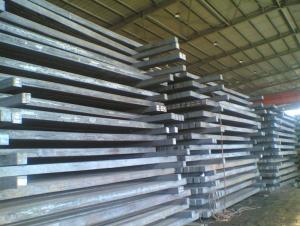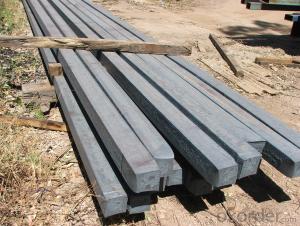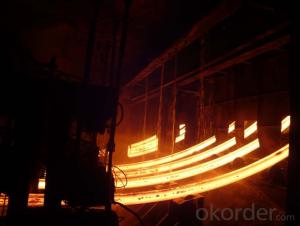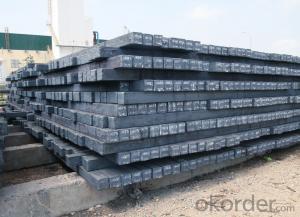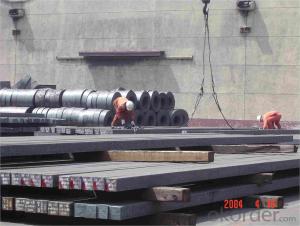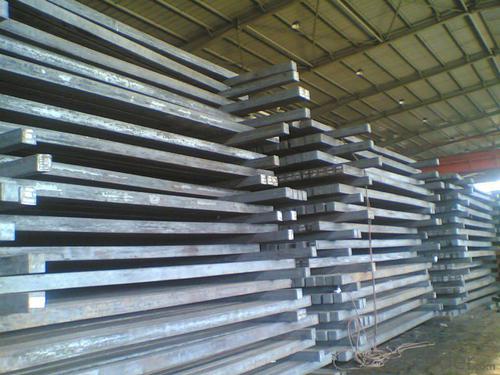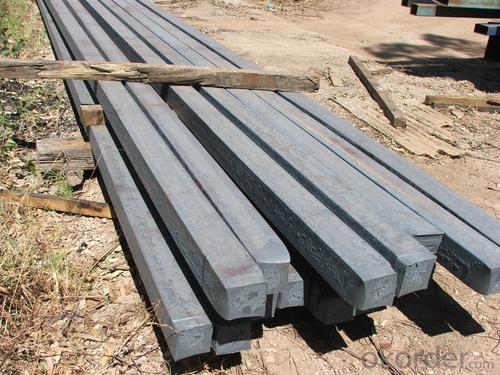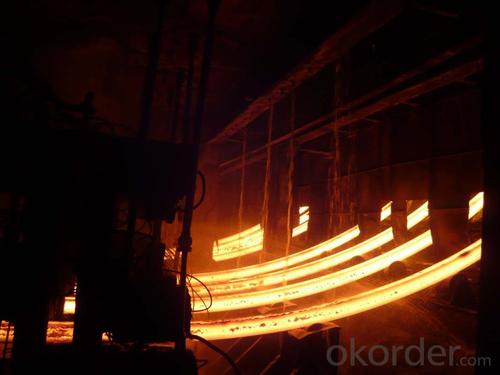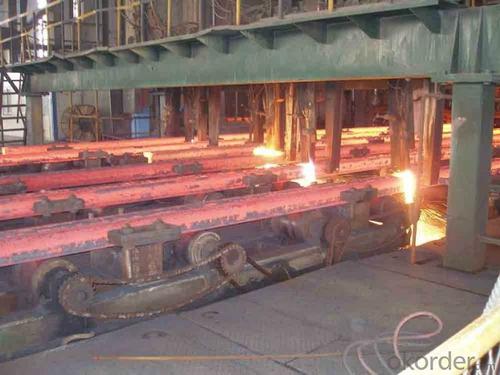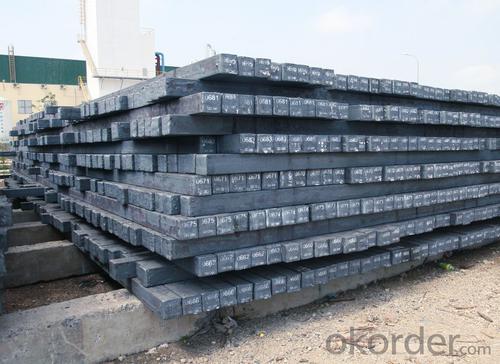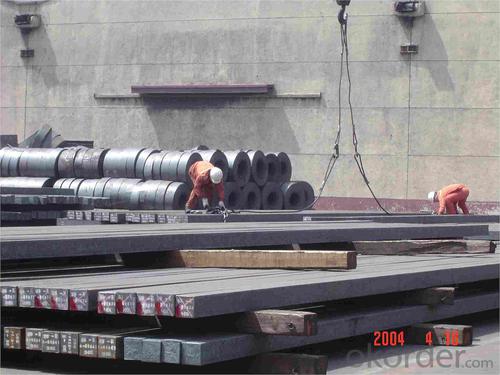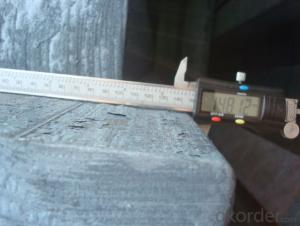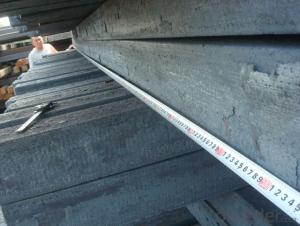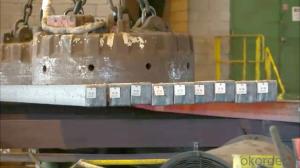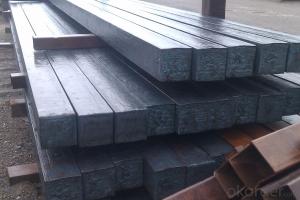Q235/3SP 175MM Blast Furnace Hot Rolled Steel Billet
- Loading Port:
- Tianjin
- Payment Terms:
- TT OR LC
- Min Order Qty:
- 2000 m.t.
- Supply Capability:
- 30000 m.t./month
OKorder Service Pledge
OKorder Financial Service
You Might Also Like
Description of Q235/3SP 175MM Blast Furnace Hot Rolled Steel Billet
Our hot dip galvanised steels consist of a steel substrate with a metallic zinc coating applied by means of a continuous hot dip galvanising process. Metallic zinc coatings are available in steel grades ranging from steel for bending and deep drawing applications, to structural steels and high yield strength steels.
A glossy surface finish obtained under specific skin-pass conditions (either non-skin-passed or skin- passed with smooth cylinders to obtain low roughness) can be provided if required at time of enquiry.
Advantage of Q235/3SP 175MM Blast Furnace Hot Rolled Steel Billet
Uncoated CR steel sheet With the features of in line with the international highest standards in demension and shape, excellent surface finish and properties, the products are mainly used in home appliance and automobile industries.
Galvanized steel sheet(include HDG and EG)
With the features of good corrosion resistance, the products are mainly used in automobile, home appliance, electronics, building and machinery manufacture industries, etc.
Precoated steel sheet With the features of enviromental protection and good processablility, long lasting surface durability, rich in colors, the products are maily used in building, home appliance and furniture industries, etc.
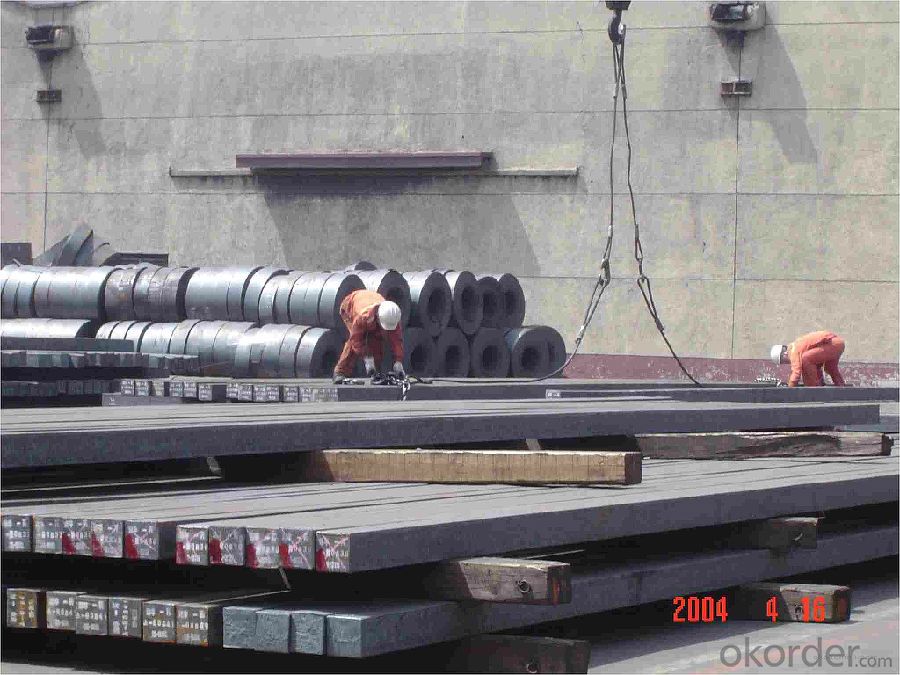
Applications of Q235/3SP 175MM Blast Furnace Hot Rolled Steel Billet
Our hot dip galvanised steels can be used in a very wide range of applications for industrial markets, both indoors and outdoors. Some of the most common applications are:
Building: wide sections for roofing and cladding, doors, door frames, metallic ceilings, partitions, structural members etc
Domestic appliances: all appliances for this sector (both white and brown goods) are manufactured with hot dip galvanised steels
Miscellaneous: electrical cabinets, aeraulic components, air conditioners, road signs etc
Zinc hot dip galvanised steel is suitable for contact with foodstuffs under certain conditions, as specified in European directive 89/109/EEC and French standard NF A 36-712-1. Please contact us for further information on this subject.
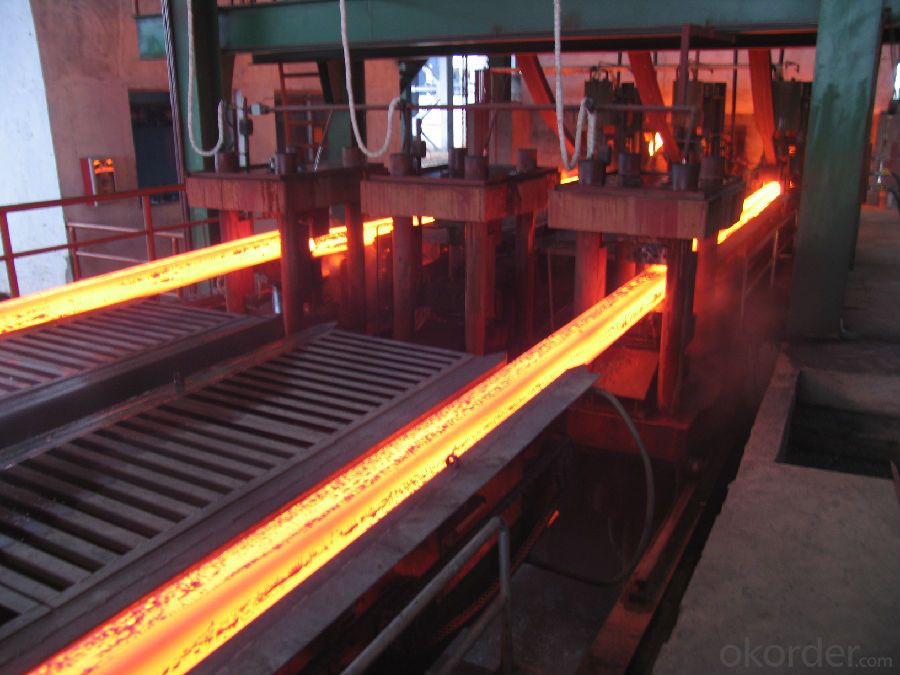
Specifications of Q235/3SP 175MM Blast Furnace Hot Rolled Steel Billet
Quality | Q/BQB 440-2003 | JIS G3312-1994 JIS G3321 | EN 10326-2004 | ASTM A653-02a |
EN 10327-2004 | (BASE PLATE) | |||
(BASE PLATE) | ||||
Commercial Steel | DC51D | SGCC SGLCC | DX51D+Z DX51D+AZ | CS Type A/B/C |
Forming Steel | St01,St02,St03 | SGCD1 SGLCD1 | FS Type A, Type B | |
Drawing | DC52D /DC53D | - | DX52D+Z DX52D+AZ | DDS TYPE A/C |
Steel | DX53D+Z DX53D+AZ | |||
Structural | S280GD (StE28) | SGC400 SGLC400 | S280D+Z DX54D+AZ | SS275 |
Steel | S350GD (StE34) | SGC440 SGLC440 | S350D+Z S350D+AZ | SS340 Class1 |
FAQ of Q235/3SP 175MM Blast Furnace Hot Rolled Steel Billet
We have organized several common questions for our clients,may help you sincerely:
1. How Can I Visit There?
Our company is located in Tianjin City, China, near Beijing. You can fly to Tianjin Airport Directly. All our clients, from home or aboard, are warmly welcome to visit us!
2. How Can I Get Some Sample?
We are honored to offer you sample.
3. Why choose CNBM?
Our delivery time about 15-20days for standard sizes, if you have other requirements like hardness, quanity and width ,it is about 20-40days. But don't worry we also try our best for the delivery time ,because time longer and our cost is higher.
- Q: How are steel billets inspected for surface defects?
- Steel billets are inspected for surface defects using various methods and techniques to ensure the quality and integrity of the material. One common method is visual inspection, where trained inspectors carefully examine the surface of the billets for any visible defects such as cracks, scratches, pits, or uneven surfaces. They use proper lighting and magnification tools to thoroughly inspect the entire surface area. Another method used is dye penetrant testing. In this technique, a liquid dye is applied to the surface of the billets, which is then allowed to seep into any cracks or defects. After a specified time, excess dye is removed, and a developer is applied. The developer draws out the dye from any defects, making them clearly visible and easy to identify. Magnetic particle inspection is another widely used method. In this process, the billets are magnetized, and iron particles are applied to the surface. Any surface defects disrupt the magnetic field, causing the iron particles to gather around the defect, making them clearly visible upon inspection. This technique is particularly effective for detecting defects such as surface cracks. Ultrasonic testing is also commonly employed for inspecting steel billets. High-frequency sound waves are transmitted through the material, and any surface defects or internal flaws cause reflections or echoes. These reflections are detected and analyzed, providing information about the size, location, and type of defect present. Additionally, eddy current testing can be used to inspect steel billets for surface defects. This method involves passing an alternating current through a probe that is placed near the surface of the billet. Any defects or variations in the material's conductivity cause changes in the eddy currents, which can be detected and analyzed to identify surface defects. Overall, steel billets undergo meticulous inspection using a combination of visual, dye penetrant, magnetic particle, ultrasonic, and eddy current testing methods to ensure that any surface defects are identified and addressed, guaranteeing the quality and reliability of the final product.
- Q: How are steel billets used in the production of machinery and equipment?
- Steel billets are an essential component in the production of machinery and equipment. These billets serve as the raw material from which various parts and components are formed. The manufacturing process begins with the selection of high-quality steel billets, which are then heated and shaped using various techniques like hot rolling, forging, or extrusion. One common application of steel billets is in the production of machine parts such as gears, shafts, and axles. These billets are heated to a specific temperature, allowing them to be easily manipulated and formed into the desired shape. Once shaped, these parts undergo further processing such as heat treatment or machining to enhance their strength, durability, and precision. Steel billets are also used in the manufacturing of heavy machinery and equipment. For instance, in the construction industry, steel billets serve as the foundation for the production of cranes, excavators, and bulldozers. These billets are molded and shaped into various structural components, providing the necessary strength and stability required for such equipment to perform heavy-duty tasks. Moreover, steel billets find application in the production of industrial machinery, such as turbines, compressors, and pumps. These billets are transformed into intricate parts that possess high strength, corrosion resistance, and the ability to withstand extreme operating conditions. The properties of steel, such as its high strength, durability, and versatility, make it an ideal material for the production of machinery and equipment. Steel billets serve as the starting point for the manufacturing process, allowing manufacturers to create complex and reliable components that are crucial for the functioning of machinery and equipment in various industries.
- Q: How are steel billets used in the manufacturing of medical devices?
- The manufacturing of medical devices relies on steel billets in multiple ways. Surgical instruments, like scalpels, forceps, and scissors, use steel billets as a raw material. These instruments demand strength, durability, and corrosion resistance, qualities that steel billets possess. Steel billets also find use in the production of implants, such as joint replacements and dental implants. These implants must withstand the body's load and stress, making steel billets an ideal material due to their outstanding mechanical properties. Furthermore, medical equipment like hospital beds, wheelchairs, and surgical tables are manufactured using steel billets. These devices require a robust structure, and steel billets provide the necessary strength and stability. Moreover, steel billets are integral to the manufacturing of medical equipment components, such as brackets, frames, and supports. These components are crucial for the proper functioning and stability of medical devices, and steel billets are often selected for their high machinability and weldability. In summary, steel billets play a vital role as a raw material in the manufacturing of diverse medical devices. Their strength, durability, corrosion resistance, and other mechanical properties make them an excellent choice for producing surgical instruments, implants, medical equipment, and their components.
- Q: How are steel billets used in the manufacturing of railway tracks?
- Steel billets are an essential component in the manufacturing of railway tracks. These billets serve as the raw material from which the tracks are formed. The process begins with the steel billets being heated to a high temperature, typically around 1200 degrees Celsius, in a furnace. This heating process helps to soften the steel and make it more malleable. Once the billets are heated, they are passed through a series of rollers in a process known as hot rolling. This process involves the billets being continually passed through the rollers to gradually reduce their thickness and shape them into long, slender strips. This hot rolling process also helps to refine the internal structure of the steel, improving its strength and durability. After the hot rolling process, the steel strips are then cut into smaller sections, known as rails. These rails are carefully inspected for any defects or imperfections before they are further processed. They undergo a process called finishing, where any surface irregularities or imperfections are removed through grinding or polishing. The finished rails are then treated with various techniques to enhance their strength and resistance to wear and tear. This may include heat treatment processes such as quenching and tempering, which further improve the rails' hardness and toughness. Additionally, the rails may be coated with protective layers to prevent corrosion and extend their lifespan. Finally, the rails are transported to the construction site where they are laid and fastened to the sleepers or ties to form the railway track. The steel rails provide a sturdy and reliable foundation for trains to travel on, with their strength and durability enabling them to withstand heavy loads and constant use. In conclusion, steel billets play a crucial role in the manufacturing of railway tracks. They are transformed through various processes into rails that provide a solid foundation for trains to run on. The use of steel billets ensures that the railway tracks are strong, durable, and capable of withstanding the demands of heavy train traffic.
- Q: What are the main challenges in the marketing of steel billets?
- There are several factors that contribute to the main challenges faced in marketing steel billets. To begin with, the highly competitive nature of the steel industry is a major hurdle. The market is saturated with numerous steel manufacturers and suppliers worldwide, making it difficult for companies to stand out and maintain a strong presence. In addition, fluctuations in global demand and supply of steel pose significant challenges. Steel billets are primarily used as raw material in industries like construction, automotive, and manufacturing. Any changes in these industries' demand directly affect the demand for steel billets. Therefore, marketing strategies must be adaptable and responsive to market dynamics in order to secure a stable customer base. Pricing is also a critical challenge. Steel billets are subject to price volatility due to factors such as raw material costs, energy prices, and global economic conditions. Companies must constantly analyze these factors to set competitive prices while ensuring profitability. Furthermore, a thorough understanding of the target market's needs and preferences is necessary for effective marketing. Different industries may require specific qualities and specifications in their billets, such as size, composition, or surface finish. To meet these requirements, companies must invest in research and development and effectively communicate the advantages of their products to potential customers. Establishing and maintaining strong relationships with customers is another challenge. Steel billets are typically sold through long-term contracts, relying on trust and reliability. Consistent quality, on-time delivery, and excellent customer service are essential for building and nurturing these relationships. Lastly, environmental sustainability has emerged as a challenge in the marketing of steel billets. With increasing environmental regulations and growing consumer awareness, companies need to position themselves as environmentally responsible and promote sustainable practices throughout their value chain. To conclude, marketing steel billets presents challenges related to intense competition, demand-supply dynamics, pricing, market understanding, customer relationships, and environmental sustainability. Overcoming these challenges requires strategic planning, continuous adaptation, and a customer-centric approach.
- Q: How do steel billets affect the overall cost of a project?
- Steel billets can significantly impact the overall cost of a project as they serve as the raw material for various steel products. The price and availability of steel billets directly influence the cost of manufacturing steel components, structures, or equipment. Fluctuations in billet prices can affect supply chain costs, transportation expenses, and ultimately impact the total project cost. Additionally, the quality and specifications of steel billets can also affect the efficiency, durability, and performance of the final product, further influencing the overall project cost.
- Q: What are the different types of casting processes used for shaping steel billets?
- Steel billets can be shaped using various casting processes. These methods include: 1. Continuous Casting: The most commonly used technique involves pouring molten steel into a continuously moving, water-cooled mold. The solidifying steel is continuously pulled out of the mold, resulting in a seamless billet. This process is efficient and allows for high production rates. 2. Centrifugal Casting: This method utilizes a rotating mold into which molten steel is poured. The centrifugal force evenly distributes the metal along the mold walls, creating a cylindrical billet. Centrifugal casting is known for producing high-quality, defect-free billets. 3. Ingot Casting: A traditional approach where molten steel is poured into a mold and left to solidify. The resulting solid steel, called an ingot, is then processed further to achieve the desired billet shape. Ingot casting offers flexibility in terms of billet size and shape. 4. Sand Casting: This process is suitable for manufacturing large and complex steel billets. It involves creating a mold using a mixture of sand and a binder. Molten steel is poured into the mold, and once it solidifies, the mold is removed to reveal the billet. While sand casting allows for custom-shaped billets, it is a slower and less precise method compared to others. 5. Investment Casting: Also known as lost-wax casting, this technique is ideal for intricate and complex billet shapes. Investment casting begins with the creation of a wax pattern in the desired shape. The wax pattern is then coated with a ceramic shell, and the wax is melted away, leaving behind a hollow mold. Molten steel is poured into the mold and solidifies, after which the ceramic shell is broken to retrieve the billet. Each casting process has its own advantages and disadvantages, and the choice depends on factors such as desired billet shape, size, production volume, and quality requirements.
- Q: What are the potential applications of steel billets in the aerospace aftermarket?
- Steel billets have various potential applications in the aerospace aftermarket. These include the manufacturing of specialized components and parts for aircraft engines, landing gears, and structural frameworks. Steel billets can also be used for repairs and replacements of damaged or worn-out aerospace components, ensuring the continued safe and efficient operation of aircraft.
- Q: How do steel billets contribute to the manufacturing of telecommunications devices?
- Steel billets play a significant role in the manufacturing of telecommunications devices in several ways. Firstly, steel billets serve as a raw material for the production of various components used in telecommunications devices. These components include structural frames, housing, brackets, and mounts, among others. The strength and durability of steel make it an ideal choice for these parts, as they need to withstand harsh environments and provide stability to the devices. Furthermore, steel billets are often used in the production of transmission towers and antenna masts, which are essential for the efficient transmission and reception of signals in the telecommunications industry. These towers and masts need to be sturdy and capable of supporting heavy equipment to ensure uninterrupted communication. Steel, with its high strength and load-bearing capacity, is an ideal material for such applications. Moreover, steel billets are also used in the manufacturing of cable trays and conduits that are essential for organizing and protecting the various cables used in telecommunications devices. These cable management systems ensure that the cables are properly routed and protected from external factors such as moisture, heat, and physical damage. Steel's resistance to corrosion and its ability to withstand extreme conditions make it an excellent choice for these purposes. In addition to its physical properties, steel billets contribute to the manufacturing of telecommunications devices due to their cost-effectiveness. Steel is widely available and relatively inexpensive compared to other materials, making it a preferred choice for manufacturers. Its versatility and ease of fabrication also contribute to the efficient production of telecommunications devices. Overall, steel billets play a crucial role in the manufacturing of telecommunications devices by providing raw materials for various components, supporting infrastructure, and ensuring efficient cable management. Their strength, durability, cost-effectiveness, and availability make them an indispensable material in the telecommunications industry.
- Q: What are the main challenges in the handling of steel billets during production?
- The production of steel billets poses various challenges that must be addressed in order to achieve a streamlined and effective manufacturing process. Weight and size are major obstacles to consider when working with steel billets. These billets can be quite hefty, ranging from a few hundred kilograms to several tons, depending on their dimensions. As a result, lifting and moving them within the production facility can be difficult. The safe handling of these heavy loads necessitates the use of specialized equipment, such as cranes and forklifts. Another challenge lies in the potential for damage during the handling of steel billets. They are typically transported and stored in stacks or bundles, and improper handling techniques or inadequate protection can result in deformation, scratches, or even breakage of the billets. These damages can negatively impact the quality of the final product, leading to increased scrap rates and production costs. Furthermore, maintaining precise temperature control is crucial when working with steel billets. Steel is highly sensitive to temperature changes, and the billets must be kept within specific temperature ranges to prevent distortion or metallurgical issues. Careful attention must be paid when transferring billets between different areas of the production facility to ensure consistent temperatures. Proper inventory management and tracking also present challenges in the handling of billets. Steel billets are often stored in large warehouses or outdoor yards, and keeping track of their location, quantity, and quality can be complex. Efficient inventory management systems, such as barcoding or RFID tagging, are essential to minimize errors and facilitate the retrieval of the necessary billets for production. Lastly, safety is a significant concern when handling steel billets. The weight of the billets and the potential for injury make it imperative to adhere to strict safety protocols. Operators must receive proper training on the use of equipment, such as cranes and forklifts, and wear appropriate personal protective equipment (PPE) to prevent accidents or injuries. In conclusion, the handling of steel billets during production presents challenges related to weight, potential damage, temperature control, inventory management, and safety. Overcoming these challenges necessitates investments in specialized equipment, training, and efficient processes to ensure a smooth and successful production operation.
Send your message to us
Q235/3SP 175MM Blast Furnace Hot Rolled Steel Billet
- Loading Port:
- Tianjin
- Payment Terms:
- TT OR LC
- Min Order Qty:
- 2000 m.t.
- Supply Capability:
- 30000 m.t./month
OKorder Service Pledge
OKorder Financial Service
Similar products
Hot products
Hot Searches
Related keywords
